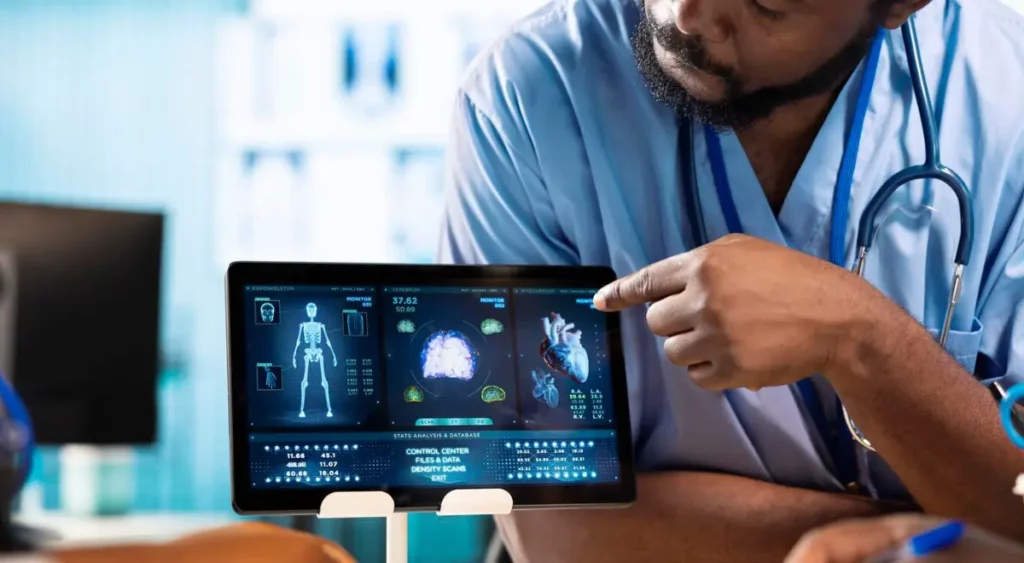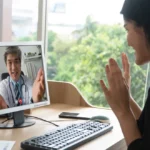Top Emerging Technologies Driving the Future of Remote Patient Monitoring

Healthcare technology is advancing at a quick pace to transform patient care and disease management for chronic patients or those in need of long-term care. Remote Patient Monitoring (RPM) is one such health technology making a noteworthy impact on the patient monitoring and care delivery model, making remote healthcare more accessible and effective.
There are several emerging technologies that are improving the RPM outcomes, including advanced sensors, wearable devices, and artificial intelligence (AI)-driven analytics. In this blog, we’ll check out the emerging technologies that are improving the healthcare landscape:
Table of Contents
ToggleWearable Devices: The Backbone of RPM
Wearable devices are the most popular and commonly used technologies in RPM that are designed to track and transmit patient’s health data to the healthcare providers in near real-time. These devices are worn by patients and measure vital signs like heart rate, body temperature, blood pressure, respiratory rate, oxygen saturation, among many others. Some of the advancements in wearable devices include:
- Non-Invasive Blood Glucose Monitoring: Previously, diabetic patients had to prick their skin and draw blood to have their blood glucose levels measured. Recent developments in the wearable technology make glucose monitoring a non-invasive process. To avoid pricking the skin, infrared spectroscopy technology is used to measure glucose levels.
- Smartwatches for Advanced Health Monitoring: Smartwatches, like Apple Watch and Fitbit have crossed into the mainstream for RPM usage. These smartwatches have ECGs, fall detection, heart rate variability parameters, blood oxygen saturation (SpO2) and even body temperature measurement.
- Continuous Glucose Monitoring (CGM): CGMs are comprised of small sensors implanted under the skin to monitor blood glucose levels. These small sensors are attached to a transmitter that provides continuous glucose data to the healthcare provider and patient. This real-time monitoring allows diabetes patients to keep their condition under control by getting updates regarding their glucose levels.
Explore cutting-edge technologies revolutionizing remote patient monitoring (RPM).
AI-powered analytics, IoT devices, wearable biosensors, and mobile platforms drive real-time insights for proactive, personalized care. HealthArc’s advanced RPM solutions empower providers with precise data, enhancing patient outcomes and transforming healthcare delivery with innovative, connected tools tailored for the future of remote monitoring.
Advanced Sensors: The Future of Health Monitoring
Advanced sensors are used in RPM devices to take remote monitoring approach to a level ahead. These sensors measure various physiological as well as biochemical markers used to monitor patients outside the clinical settings. Types of advanced sensors used in RPM include:
- Chronic Disease Management Biosensors: Tracking biomarkers such as glucose and sodium levels are used to manage long-term diseases like diabetes, heart diseases, and kidney failure. In fact, these biosensors detect the levels on a continuous basis and generate alerts to both the patient and healthcare provider for any fluctuations in vital levels.
- Smart Patches: Smart patches are adhesive sensors that are put onto the skin to measure and monitor glucose or hydration levels or body temperature. These patches are small, less visible, and perfect for wearing for long periods, making them a great choice for keeping a close eye on health vitals over time.
- Wearable ECG Monitors: Monitoring the heart activity with the help of electrocardiography wearable ECG monitors plays a significant role in improving the patient’s health by keeping a close track of the heart readings outside of clinical settings.
Artificial Intelligence (AI) Driven Analytics
Artificial Intelligence is expected to transform the healthcare sector by enhancing decision making, predictive analytics, and personalized treatments. AI analytics play a key role in remote patient monitoring by analyzing huge amounts of data sets generated from wearables and sensors, identifying trends in patient data, detecting early warning signs, or predicting health outcomes. Here are some technologies that are helping AI in revolutionizing RPM:
- Predictive Analytics: AI algorithms work on large amount of patient data and use predictive analytics to identify patterns, assess risk factors, and correlate possible future health events. In case, a sudden abnormal change in trend of a patient’s parameter triggers warning signs of a heart attack or stroke, the AI would generate alarms or notification alerts so healthcare providers could take preventive measures to minimize the risk to the patient.
- Natural Language Processing (NLP): AI powered Natural Language Processing helps analyze unstructured data from patient notes, chatbots, and multiple sources of text. NLP facilitates generating health insights from patient data, thus enhancing clinical decision making and improving patient care.
- AI-Enhanced Medical Imaging: Remote diagnostics through medical imaging is part of the RPM workflow. Machine-learning algorithms allow AI to analyze images acquired through ultrasound, ECG machines, etc., thereby providing an accurate diagnosis remotely without requiring the patient to step into a healthcare facility.
The Integration of 5G Networks
The rollout of 5G networks is influencing the future of remote patient monitoring in a convenient way. It promises high data rates, low latency, and wide bandwidth, which are all critical technical requirements for real-time patient monitoring and healthcare provider communication. Some benefits of 5G networks in RPM include:
- Real-Time Data Transfer: Real-time transfer of patient information from monitoring devices to the medical service provider is possible via real-time monitoring using 5G technology. Healthcare providers would be able to immediately intervene to any changes noticed in a patient′s health status, or whenever any fluctuations in patient data are detected.
- Better Remote Consultations: Cellular medical devices equipped with 5G can greatly enrich the patient experience with high-definition video-based consultations, real-time sharing of images and seamless interaction between patients and healthcare providers, all from their comfort zones.
Conclusion
The latest RPM technologies, including advanced sensors, AI-driven analytics, wearable devices, and the expansion of 5G networks are believed to revolutionize the remote monitoring era. These sensors and devices facilitate an increased level of continuous monitoring of patients, early detection of health issues, and personalized care to get better patient outcomes at a lower cost.
The evolution in RPM technology will pave the way toward a new care delivery model, which is more efficient, accessible, and proactive. Patients can benefit from better chronic disease management and fewer hospital visits, with improved health outcomes.
Invest in HealthArc’s Remote Patient Monitoring Platform
HealthArc’s RPM platform supports improved clinical outcomes and offers tools to enhance revenue generation through care management reimbursements. Our platform seamlessly integrates with Electronic Health Records (EHRs) and other linked devices that use external APIs to provide a detailed report of a patient’s clinical data analytics. The platform provides analytics at a program level, practice level, and delivers clinical insights that help providers make informed care decisions.
All our devices are network independent and 4G enabled with a 2G fall back option. Not only this, they work outside of the US too, with hassle-free connectivity in 150+ countries. Though cellular-based, you can store the readings offline too, and get them online as soon as the patient is back in the serviceable area.
HealthArc maintains strict data privacy and security protocols and is fully compliant with HIPAA and SOC 2 frameworks.
Schedule a free demo today to find out how our platform works or call us today at (201) 885 5571 to know which emerging RPM technology is best for your clinical practice.
Frequently Asked Questions (FAQs)
Wearable devices, such as fitness trackers and smart watches, are revolutionizing RPM. They send information straight to your healthcare team, including your pulse, oxygen levels, and even your level of activity. This process enables your physician to identify any warning signs early and modify your treatment plan as necessary.
AI in RPM finds out unusual patterns or warnings, such as if your blood sugar is out of control; it sorts through a ton of health data. This promotes long-term health by enabling your doctor to intervene before health issues escalate.
Advanced sensors function as health investigators. They take accurate measurements, like your blood sugar levels and respiration rate. Early detection of minor changes enables your doctor to respond timely, reducing hospital stays and maintaining control of your condition.
5G functions like an extremely fast highway, allowing patients to send health data to their healthcare team. Even if you live far away, it enables RPM devices to instantly send information to your doctor.
Yes, reputable RPM platforms, such as HealthArc, protect your data by using the best encryption and adhering to stringent regulations like HIPAA and SOC 2. When your doctor receives your health information, it remains confidential and secure.
It reduces the need for doctor visits by enabling you to keep an eye on your health from home. Additionally, it provides your care team with real-time updates so they can intervene promptly if something seems off.
Yes, HealthArc is one of many RPM devices that are compatible with more than 150 countries. No matter where you travel, you can maintain your health, as these devices can store your data offline and sync it up when you return to a connected area.
Electronic Health Records (EHRs) are compatible with the majority of RPM platforms. As a result, your doctor can more easily see the big picture and make informed decisions about your care because your health data is directly transferred into their system.
RPM streamlines care by cutting down on unnecessary hospital visits and catching issues early. For doctors, it also provides opportunities for reimbursement, such as Medicare’s care management programs, which can benefit both your health and their practice.
Most Recent Blogs
Categories
Related Blog
- November 26, 2025 | Read Time: 14 mins
Return on Investment (ROI) of Remote Patient Monitoring (RPM): A Complete Guide for ACOs and Healthcare Organizations
The U.S. healthcare system continues its transition from fee-for-service models to value-based...
Learn More- November 24, 2025 | Read Time: 15 mins
Common RPM Pricing Models for Providers: A Profitability-Focused Guide
Remote Patient Monitoring (RPM) has rapidly emerged as one of the leading...
Learn More- October 23, 2025 | Read Time: 12 mins
How RPM Devices Improve Hypertension and Diabetes Outcomes in Medicare Populations
Remote patient monitoring (RPM) is transforming chronic care for Medicare beneficiaries. CMS...
Learn More


